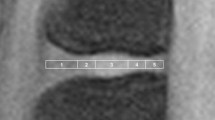Abstract
Purpose
To evaluate the role of apparent diffusion coefficient (ADC) as a quantitative means to assess the degree of intervertebral disc (IVD) degeneration contextually within the framework of a widely used Pfirrmann classification rather than in a direct correlation with Pfirrmann grades.
Methods
DWI and T2-weighted (T2w) of lumbar spine were acquired from nine healthy volunteers (age range 27–62 years, mean age 45 years) with a 3T MR scanner. ADC values were obtained from each of the five lumbar discs via a pixel-by-pixel ADC calculation as well as via region of interest-averaged image intensities. Disc degeneration was assessed by a scoring system via sequential application of Pfirrmann scale and use of intensity ratio of IVD/cerebrospinal fluid in T2w for discs in each Pfirrmann grade to be further separated.
Results
A significant correlation was observed between degenerative scores and ADC independent of how ADC was obtained (Spearman’s ρ < −0.85, P < 2 × 10−14).
Conclusions
This study demonstrates that previously perceived as an overlap in ADC value existing between different degenerative categories based on a visual inspection can be viewed as a quantitative role of ADC in assessment of disc degeneration. This reinforces the Pfirrmann classification system but also proceeds beyond mere qualitatively determining morphologic states.




Similar content being viewed by others
References
Pfirrmann CW, Metzdorf A, Zanetti M, Hodler J, Boos N (2001) Magnetic resonance classification of lumbar intervertebral disc degeneration. Spine 26:1873–1878
Auerbach JD, Johannessen W, Borthakur A et al (2006) In vivo quantification of human lumbar disc degeneration using T1 ρ -weighted magnetic resonance imaging. Eur Spine J 15(suppl. 3):S338–S344
Kerttula L, Kurunlahti M, Jauhiainen J, Koivula A, Oikarinen J, Tervonen O (2001) Apparent diffusion coefficients and T2 relaxation time measurements to evaluate disc degeneration: a quantitative MR study of young patients with previous vertebral fracture. Acta Radiol 42:585–591
Marinelli NL, Haughton VM, Anderson PA (2010) T2 relaxation times correlated with stage of lumbar intervertebral disk degeneration and patient age. Am J Neuroradiol 31:1278–1282
Niu G, Yang J, Wang R, Dang S, Wu EX, Guo Y (2011) MR imaging assessment of lumbar intervertebral disk degeneration and age-related changes: apparent diffusion coefficient versus T2 quantitation. Am J Neuroradiol 32:1617–1623
Kurunlahti M, Kerttula L, Jauhiainen J, Karppinen J, Tervonen O (2001) Correlation of diffusion in lumbar intervertebral disks with occlusion of lumbar arteries: a study in adult volunteers. Radiology 221:779–786
Kealey SM, Aho T, Delong D, Barboriak DP, Provenzale JM, Eastwood JD (2005) Assessment of apparent diffusion coefficient in normal and degenerated intervertebral lumbar disks: initial experience. Radiology 235:569–574
Niinimäki J, Korkiakoski A, Parviainen O et al (2009) Association of lumbar artery narrowing, degenerative changes in disc and endplate and apparent diffusion in disc on postcontrast enhancement of lumbar intervertebral disc. Magn Reson Mater Phys Biol Med 22:101–109
Niinimäki J, Korkiakoski A, Ojala O et al (2009) Association between visual degeneration of intervertebral discs and the apparent diffusion coefficient. Magn Reson Imaging 27:641–647
Beattie PF, Morgan PS, Peters D (2008) Diffusion-weighted magnetic resonance imaging of normal and degenerative lumbar intervertebral discs: a new method to potentially quantify the physiologic effect of physical therapy intervention. J Orthop Sports Phys Ther 38:42–49
Ludescher B, Effelsberg J, Martirosian P et al (2008) T2- and diffusion-maps reveal diurnal changes of intervertebral disc composition: an in vivo MRI study at 1.5 Tesla. J Magn Reson Imaging 28:252–257
Rajasekaran S, Babu JN, Arun R, Armstrong BR, Shetty AP, Murugan S (2004) ISSLS prize winner: a study of diffusion in human lumbar discs: a serial magnetic resonance imaging study documenting the influence of the endplate on diffusion in normal and degenerate discs. Spine 29:2654–2667
Rajasekaran S, Babu JN, Murugan S (2007) Review of postcontrast MRI Studies on diffusion of human lumbar discs. J Magn Reson Imaging 25:410–418
Rajasekaran S, Venkatadass K, Naresh-Babu J, Ganesh K, Shetty AP (2008) Pharmacological enhancement of disc diffusion and differentiation of healthy, ageing and degenerated discs. Eur Spine J 17:626–643
Griffith JF, Wang YJ, Antonio GE et al (2007) Modified Pfirrmann grading system for lumbar intervertebral disc degeneration. Spine 32:E708–E712
Antoniou J, Demers CN, Beaudoin G et al (2004) Apparent diffusion coefficient of intervertebral discs related to matrix composition and integrity. Magn Reson Imaging 22:963–972
Hilibrand AS, Robbins M (2004) Adjacent segment degeneration and adjacent segment disease: the consequences of spinal fusion? Spine J 4:190S–194S
Yu HJ, Bahri S, Muftuler LT, Nalcioglu O, Gardner V (2011) Correlation between ADC and T1 ρ -relaxation time for in vivo assessment of intervertebral disc degeneration. In: ISMRM 19th annual meeting and exhibition, Montreal, p 3242
Zobel BB, Vadalà G, Vescovo RD et al (2012) T1 ρ magnetic resonance imaging quantification of early lumbar intervertebral disc degeneration in healthy young adults. Spine 37:1224–1230
Conflict of interest
Funding support in part by CardioVascular BioTherapeutics (CVBT), Inc. Vance Gardner is a former consultant of CVBT. For the remaining authors no conflicts of interest were declared.
Author information
Authors and Affiliations
Corresponding author
Rights and permissions
About this article
Cite this article
Yu, H.J., Bahri, S., Gardner, V. et al. In vivo quantification of lumbar disc degeneration: assessment of ADC value using a degenerative scoring system based on Pfirrmann framework. Eur Spine J 24, 2442–2448 (2015). https://doi.org/10.1007/s00586-014-3721-0
Received:
Revised:
Accepted:
Published:
Issue Date:
DOI: https://doi.org/10.1007/s00586-014-3721-0




